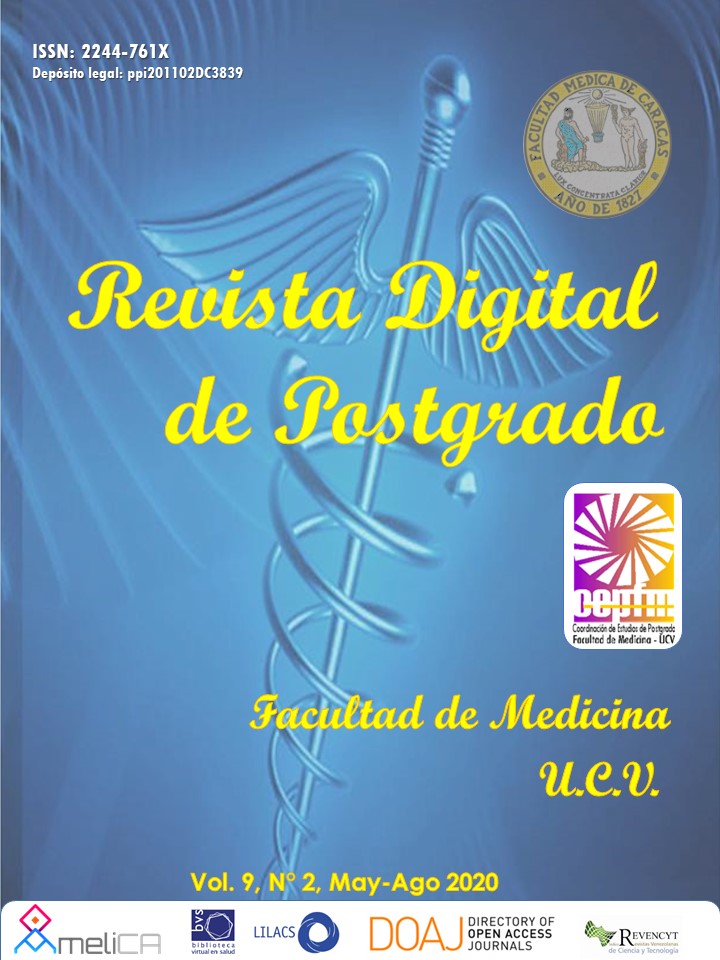Correlation of body mass index and percentage of body fat in the assessment of overweight and obesity
Keywords:
BMI, new BMI, Overweight, Obesity, Correlation.Abstract
Objective: to correlate body mass index (BMI) with percentage of body fat (%BF), in order to observe the differences in the incidence of overweight and obesity, according to criteria considered. Methods: descriptive, prospective, transversal, analytical and correlate study in patients who attended external consultation of a private medical center in Caracas, during the period September-November 2015, consisting of 633 patients, 178 (28.1%) male and 455 (71.9%) feminine 20 to 96 years old. Variables: Age, Weight, Size, and calculated BMI, new BMI, %BF by Duerenberg and by regression; are considered four age groups: < 60, 60-69, 70-79 and 80 years, and four geographic regions: Central-Western, Miranda, Maracaibo and East. Results: overweight percentages, for BMI-WHO and BMI-Oxford, non-significant, obesity percentages, significant (p<0.000); overweight and obese percentages for %BF non-significant (p>0.5); significant obesity percentages (p<0.000). The BMI-WHO and BMI-Oxford per region range from 24.5 to 28.7, and by age group range from 26.3 to 28.5; the %GC Duerenberg and %BF Regression range from 34.6 to 41; BMI-WHO correlates weight, BMI-Oxford and %BF Duerenberg (r x 0.81, r x 0.99 and r x 0.72; p < 0.000), BMI-Oxford %correlate %BF Duerenberg (r x 0.78; p < 0.000); %BF Regression correlates with BMI-OMS, BMI-Oxford, and %BF Duerenberg (r x 0.79, r x 0.86, and r x 0.89; p < 0.000). Conclusion: In view of these results, the two %BF formulas may be considered to estimate the percentage of body fat in groups of patients, regardless of age.Downloads
References
Speakman J. Obesity: the integrated roles of environment and genetics. J Nutr. 2004; 134:2090S-2105S.
Mejor estilo de vida.net. Un encuentro de salud y bienestar. [Internet] 2011; [Citado 2020 Jul 13]. Disponible en: http://mejorestilodevida.net/salud/obesidad/obesidad-prevalencia.htm
Mejor estilo de vida.net. Índice de Masa Corporal. [Internet] 2011; [Citado 2020 Jul 13]. Disponible en: http://www.medicinapreventiva.com.ve/articulos/IMC.htm
Organización Mundial de la Salud. Comité de Expertos de la OMS sobre el estado físico: El estado físico: uso e interpretación de la antropometría. Serie de informes técnicos, 854. [Internet] Ginebra (Suiza): Organización Mundial de la Salud. 1995; [Citado 2020 Jul 13]. Disponible en: http://es.wikipedia.org/wiki/%C3%8Dndice_de_masa_corporal
Organización Mundial de la Salud. Obesity: preventing and managing the global epidemic. Report of a WHO Consultation. [Internet] WHO Technical Report Series 894. Geneva. 2000; [Citado 2020 Jul 13]. Disponible en: http://www.who.int/nutrition/publications/obesity/en/index.html
Sociedad Española para el Estudio de la Obesidad, SEEDO. Consenso SEEDO 2007 para la evaluación del sobrepeso y la obesidad y el establecimiento de criterios de intervención terapéutica. Rev. Esp. Obes. 2007; 5(3): 7-48.
Trefethen N. University of Oxford. the Economist [Internet] 5 January. 2013; [citado 2020 Mar 04] Disponible en: htpps://www.TheEconomist.5January2013.New%20BMI%20(New%20Body%20Mass%20Index).html
Pumitas Futbol. Obesidad. [Internet] 2011; [citado 2020 Mar 04] Disponible en: http://www.pumitasfutbol.unam.mx/obesidad.html.
IAFdaily Staff. Cálculo del IMC, morfología y grasa corporal. El nacimiento del Índice de Masa Corporal. [Internet] 2016; [citado 2020 Jul 13]. Disponible en: https://blog.iafstore.com/es/calculo-del-imc-morfologia-y-grasa-corporal-a279
Carbajal Azcona Á. Manual de Nutrición y Dietética. Departamento de Nutrición. Facultad de Farmacia. Universidad Complutense de Madrid. [Internet] 2013; [Citado 2020 Mar 07]. Disponible en: https://www.ucm.es/data/cont/docs/458-2013-07-24-cap-2-composicion-corporal55.pdf
Krachler B, Völgyi E, Savonen K, Tylavsky FA, Alén M, Cheng S. BMI and an anthropometry-based estimate of fat mass percentage are both valid discriminators of cardiometabolic risk: a comparison with DXA and bioimpedance. J Obes. 2013; 2013:862514.
Gottau G. Índice de masa corporal y porcentaje de grasa en el cuerpo. [Internet]. Vitónica. 2009; [Citado 2020 Mar 04]. Disponible en: https://www.vitonica.com/anatomia/indice-de-masa-corporal-y-porcentaje-de-grasa-en-elcuerpo
World Medical Association, WMA. Declaration of Helsinki – Ethical principles for Medical Research Involving Human Subjects. [Internet] 2013; [citado 2020 Mar 04] Disponible en: https://www.wma.net/wp-content/uploads/2016/11/DoH-Oct2013-JAMA.pdf
Méndez-Pérez B, Martín-Rojo J, Castro V, Herrera-Cuenca M, Landaeta-Jiménez M, Ramírez G, et al. Estudio Venezolano de Nutrición y Salud: Perfil antropométrico y patrón de actividad física. Grupo del Estudio Latinoamericano de Nutrición y Salud. An Venez Nutr 2017; 30(1): 53-67.
Villatoro-Villar M, Mendiola-Fernández R, Alcaráz-Castillo X, Mondragón-Ramírez GK. Correlación del índice de masa corporal y el porcentaje de grasa corporal en la evaluación del sobrepeso y la obesidad. Rev Sanid Milit Mex. 2015; 69(6): 568-578.
Oliveira M, Fagundes R, Moreira E, Trindade E, Carvalho T. Relación de indicadores antropométricos con factores de riesgo para enfermedad cardiovascular. Arq Bras Cardiol. 2010; 94( 4 ): 478-485.
How to Cite
Issue
Section
License
Usted es libre de:
- Compartir — copiar y redistribuir el material en cualquier medio o formato
- Adaptar — remezclar, transformar y construir a partir del material
- para cualquier propósito, incluso comercialmente.
Bajo los siguientes términos:
-
Atribución — Usted debe dar crédito de manera adecuada, brindar un enlace a la licencia, e indicar si se han realizado cambios. Puede hacerlo en cualquier forma razonable, pero no de forma tal que sugiera que usted o su uso tienen el apoyo de la licenciante.
- No hay restricciones adicionales — No puede aplicar términos legales ni medidas tecnológicas que restrinjan legalmente a otras a hacer cualquier uso permitido por la licencia.











